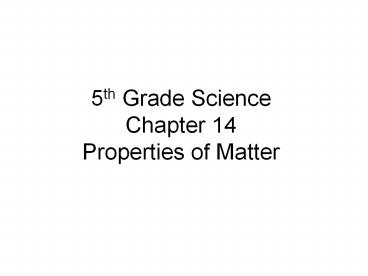5th Grade Science Chapter 14 Properties of Matter - PowerPoint PPT Presentation
1 / 36
Title:
5th Grade Science Chapter 14 Properties of Matter
Description:
5th Grade Science Chapter 14 Properties of Matter Combustibility-a measure of how easily a substance will burn, or combine rapidly with oxygen Corrosion of metal ... – PowerPoint PPT presentation
Number of Views:3939
Avg rating:3.0/5.0
Title: 5th Grade Science Chapter 14 Properties of Matter
1
5th Grade ScienceChapter 14Properties of Matter
2
matter
- Anything that has mass and takes up space is
matter
http//www.chem4kids.com/files/matter_intro.html
3
volume
- The amount of space an object takes up
- Another word for volume is capacity
4
What are two properties of matter?
5
What are two properties of matter?
- All matter has mass and takes up space.
6
atom
- The smallest particle that can still be
identified as the matter it came from is an atom
7
molecule
- A molecule is made up to two or more atoms joined
together. - Water is a molecule made of two hydrogen atoms
and one oxygen atom.
This is a DNA molecule
8
nucleus
- The dense area in the center of an atom.
- Inside the nucleus of every atom are smaller
particles called protons, electrons, and neutrons.
9
What is an atom and what are its parts?
10
What is an atom and what are its parts?
- An atom is the smallest particle of matter
- that still behaves like the matter it came
- from.
- An atom is made of protons, neutrons, and
electrons.
http//www.harcourtschool.com/activity/science_up_
close/519/deploy/interface.html
11
element
- Matter that is made of only one kind of atom is
an element. - Carbon, hydrogen, and oxygen are all elements.
- The picture is of the element zinc in hydrogen
chloride.
Zinc HCL
12
periodic table
- Scientists use the periodic table to organize
elements. - Each element has its own special place on the
table. - The places are decided by the characteristics of
the element.
13
How are the elements arranged in the periodic
table?
- Elements are arranged in order by their atomic
number - The atomic number is the number of protons in the
nucleus
14
Solid Liquid Gas
15
States of Matter Demonstration
- http//www.harcourtschool.com/activity/states_of_m
atter/index.html - http//www.chem4kids.com/files/matter_states.html
- http//www.chem4kids.com/files/matter_changes.html
16
Solid Liquid Gas
Has definite shape
Particles are close together and slow moving
Has volume http//www.chem4kids.com/files/matter_solid.html
17
Solid Liquid Gas
Has a definite shape Takes on shape of container
Particles are close together and slow moving Particles are farther apart and faster-moving
Has volume Has volume http//www.chem4kids.com/files/matter_liquid.html
18
Solid Liquid Gas
Has a definite shape Takes on shape of container Does not have definite shape
Particles are close together and move slowly Particles are farther apart and faster moving Particles are farthest apart and move rapidly
Has volume Has volume Expands to take up whatever space is available http//www.chem4kids.com/files/matter_gas.html
19
How are particles arranged in solids, liquids,
and gases?
20
How are particles arranged in solids, liquids,
and gases?
- The particles of solids are close together and
slow-moving. - The particles of liquids are farther apart and
faster-moving than solids. - The particles of gases are farthest apart and
move most rapidly.
21
Draw a model representing how particles are
arranged in solids, liquids, and gases.
- Check pg. 444 in your text for examples.
22
5th Grade ScienceChapter 14 Properties of Matter
- Changing States of Matter
23
Physical change-a change in state
- The substance is still the same substance
- Form changes but chemical makeup doesnt
24
Ice changes to waterwater changes to ice, frozen
water is still water
25
Water changes to steam, a gas, when it is heated
to its boiling point,water vapor condenses to
form a liquid
26
Changing States of Matter-Water
- Water freezes at 0 degrees Celsius, 32 degrees
Fahrenheit - Water boils at 100 degrees Celsius, 212 degrees
Fahrenheit - http//www.chem4kids.com/files/matter_chemphys.htm
l
27
(No Transcript)
28
Physical Propertiesdescribe matter
- Melting and boiling point are physical properties
(the temperature at which a substance melts or
boils) - State of matter is also a physical property
(solid, liquid, gas) - Density is a physical property
- Density is a measure of how closely packed an
objects atoms are - http//www.harcourtschool.com/activity/hotplate/in
dex.html
29
Mixtures and Solutions
- Mixtures
- A combination of two or more substances
- The substances in a mixture arent permanently
combined - Substances can be separated from the mixture and
be the same as they were before they were mixed - http//www.chem4kids.com/files/matter_mixture.html
- http//www.chem4kids.com/files/matter_mixtureex.ht
ml
30
Mixtures and Solutions
- Solutions
- A mixture in which all parts are mixed evenly
- Can be combinations of gases, liquids, and even
solids - http//www.harcourtschool.com/activity/mixture/mix
ture.html - http//www.chem4kids.com/files/matter_solution.htm
l
31
Insert videoMatter and Energy-What is It?
- http//ippex.pppl.gov/interactive/matter/molecule.
html
32
Other Physical Changes
- Breaking
- Crushing
- Cutting
- Bending
- Melting
- Freezing
- Boiling
- Can happen naturally
- People can cause changes
- Water evaporating
- Rain falling and causing pufflrd
- People cause change
- Recycling paper
- Recycling metal
33
Chemical Properties and Changes
- Chemical changes change the chemical nature and
properties of substances to form new substances - A match burns
- Two substances mix together turn a color
different from either of them - Toasting marshmallows
- Melt itphysical change
- Burn itchemical change
34
(No Transcript)
35
Combustibility-a measure of how easily a
substance will burn, or combine rapidly with
oxygen
- Corrosion of metalwhen iron combines with oxygen
in the air, rust forms - Gas bubbleshydrogen peroxide on a cut
- A change in color--fireworks
36
Conservation of Matter
- Chemical changes dont make new matter
- The total mass of the products that form equals
the total mass of the substances that react.































